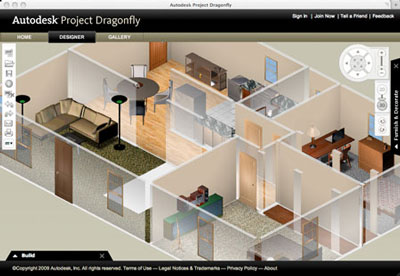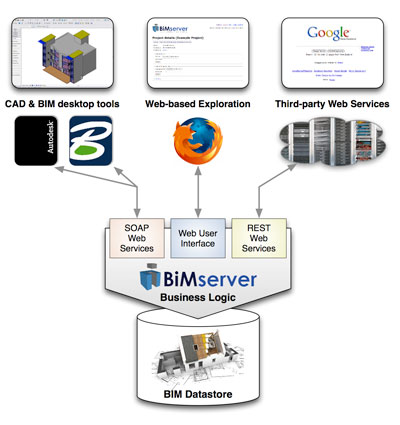We are now at a stage where a computer's speed and network connection are no longer significant process bottlenecks in digital architectural design. As a consequence the need for efficient digital collaboration tools within the architecture, engineering and construction (AEC) industry is a growing requirement. The BIMserver project from TNO and the University of Eindhoven is exploring how collaborative design can be improved through the combination of Building Information Model (BIM) and open source server technologies. Unlike conventional, workstation-based CAD software, BIMserver stores BIM data within a dedicated server where it can be accessed by all members of the design team simultaneously. Whilst conceptually not a new idea, the project is the first to move beyond the research lab and be promoted as software (almost) ready for production deployment within AEC organisations.
What is a BIM server?
BIM in its most general sense is a collection of 2D, 3D and textual data that when assembled within a computer’s memory creates an accurate and detailed representation of an architectural project. Like its predecessor CAD, BIM data is typically stored in a digital file (or files) where it is accessed directly by complex, workstation-based applications such as Revit and Microstation. In contrast a BIM server stores all design data internally and exposes its information to client applications through a series of well controlled and documented interfaces. This has a number of practical and technical advantages, the most significant being all client applications read from, and write to, the same digital model. In comparison when using a file-based BIM it is up to each participant to ensure they are working on the latest revision of the project’s files. Additionally by centralising the flow of data a BIM server enables near real-time collaboration as changes to the model are reflected on all clients each time their view of the data is refreshed from the server.
Another important characteristic of a BIM server is that the building model exists as a live entity, distinct from the client applications that interact with it. This means client applications are simpler to write because they do not need to know how to comprehend an entire digital model, they simply need to ask the BIM server for the subset of information that concerns them. For example using a traditional file-based BIM an application that counts the number of doors in a design needs to parse the file, construct an in-memory model, and then count the door instances. In comparison a BIM server handles the parsing of the digital model, all the client application needs to do is construct a query that asks how many doors the design has. Another benefit of a live BIM is that the server can automatically respond to outside events such as scheduled processes or changes to data hosted by external services. For example the BIM server could monitor the pricing and availability of materials used in the design and automatically update the model to reflect these variations. The end result is that instead of being viewed as a static, “dumb” file, the migration of the Building Information Model into a server would create a far more dynamic and accessible project resource.



